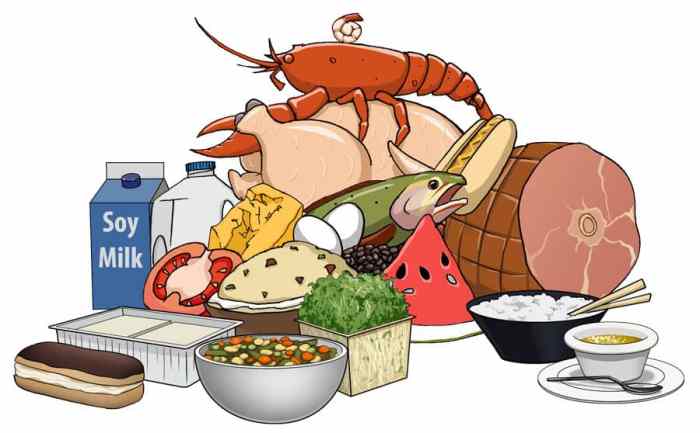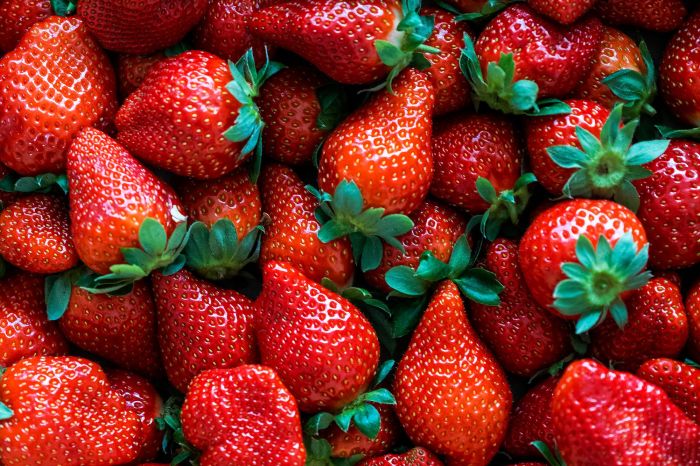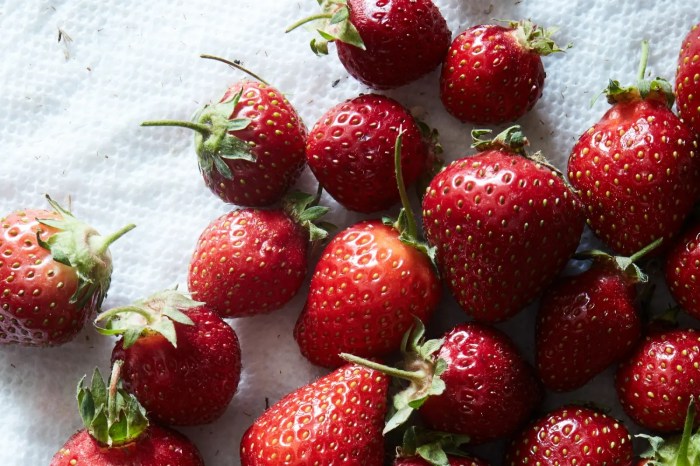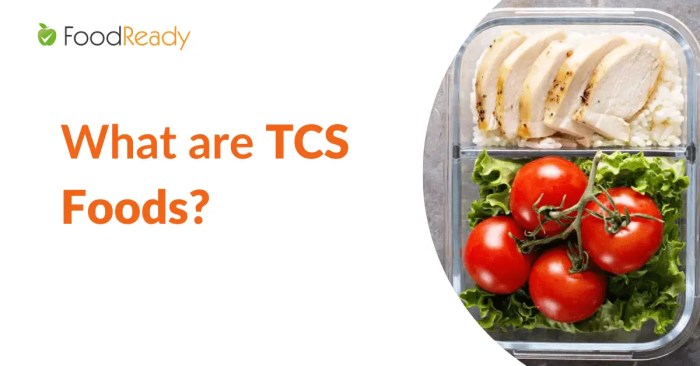Are strawberries a tcs food – Are strawberries TCS foods? The answer is a resounding yes! Join us as we delve into the fascinating world of Temperature Controlled for Safety (TCS) foods, uncovering the secrets behind the classification of strawberries and exploring their culinary adventures. Get ready for a journey that’s as informative as it is delicious!
Strawberries, the beloved summer treat, are not just a delightful indulgence but also a prime example of TCS foods. Their delicate nature demands careful handling and storage to ensure their safety and preserve their vibrant flavors.
Dietary Classification

TCS (Temperature Controlled for Safety) foods are foods that require refrigeration to prevent the growth of harmful bacteria. These foods are typically perishable and can become unsafe to eat if they are not kept at the proper temperature.
Some examples of TCS foods include:
- Meat, poultry, and seafood
- Dairy products
- Eggs
- Cooked rice
- Sprouts
- Fresh fruits and vegetables
Strawberries are considered a TCS food because they are a perishable food that can become unsafe to eat if they are not kept at the proper temperature. Strawberries are a good source of vitamins and minerals, but they can also harbor harmful bacteria if they are not handled properly.
Storage and Handling

Strawberries are delicate fruits that require proper storage and handling to maintain their quality and safety.
Strawberries might be a delicious and nutritious snack, but did you know that they’re also a part of the conversation surrounding climate change? Just like how the Paris Accord pros and cons are being debated, the impact of strawberries on our environment is also a topic of discussion.
So, while you enjoy your next strawberry, remember that it’s not just a tasty treat, but also a reminder of the complex relationship between food and our planet.
To prevent the growth of harmful bacteria and extend their shelf life, strawberries should be stored at the optimal temperature of 32-36°F (0-2°C) with high humidity. Higher temperatures can accelerate spoilage and promote the growth of mold and bacteria, while lower temperatures can cause chilling injury and damage the fruit’s texture and flavor.
Handling
* Handle strawberries gently to avoid bruising or damaging their delicate skin.
- Avoid washing strawberries before storing them, as excess moisture can promote spoilage.
- Store strawberries in a single layer to prevent crushing and bruising.
- If possible, use a container with ventilation holes to allow for air circulation and prevent condensation.
- Discard any strawberries that show signs of spoilage, such as mold, bruising, or soft spots.
Nutritional Value

Strawberries are a nutritious fruit packed with essential vitamins, minerals, and antioxidants. They are a good source of vitamin C, an antioxidant that helps protect cells from damage, and manganese, a mineral that supports bone health and metabolism. Strawberries also contain significant amounts of fiber, potassium, and folate.
Comparison to Other Fruits
Compared to other fruits, strawberries have a relatively high nutritional value. They contain more vitamin C than oranges, more potassium than bananas, and more fiber than blueberries. This makes them a valuable addition to a healthy diet.
Effect of TCS Classification
The TCS classification of strawberries as a TCS food means that they are highly perishable and must be handled properly to prevent the growth of harmful bacteria. This includes storing them at the proper temperature and avoiding cross-contamination. Proper handling can help preserve the nutritional value of strawberries and ensure that they are safe to eat.
Culinary Applications

The versatility of strawberries extends beyond their natural consumption. Their sweet and tangy flavor profile lends itself to a wide range of culinary applications, from classic desserts to savory dishes.
The delicate texture of strawberries makes them a popular choice for fresh fruit salads, fruit platters, and fruit tarts. Their vibrant red color adds a pop of vibrancy to any dish. The natural sweetness of strawberries pairs well with whipped cream, ice cream, and other desserts.
Sweet Applications, Are strawberries a tcs food
- Strawberry Shortcake:A classic American dessert that combines sweet strawberries with a fluffy biscuit-like shortcake and whipped cream.
- Strawberry Pie:A traditional fruit pie with a flaky crust filled with juicy strawberries and a sweet glaze.
- Strawberry Jam:A versatile condiment made by cooking strawberries with sugar until they form a thick spread.
- Strawberry Smoothies:A refreshing and nutritious blend of strawberries, yogurt, and other fruits or vegetables.
- Strawberry Ice Cream:A creamy and indulgent dessert that captures the essence of fresh strawberries.
Savory Applications
While strawberries are primarily associated with sweet dishes, they can also add a touch of sweetness and complexity to savory dishes.
- Strawberry Salad:A refreshing salad that combines strawberries with greens, nuts, and a tangy vinaigrette.
- Strawberry Salsa:A flavorful salsa made with strawberries, tomatoes, onions, and cilantro.
- Strawberry Chicken:A grilled or roasted chicken dish topped with a sweet and savory strawberry sauce.
- Strawberry Pizza:A unique pizza with a strawberry-infused sauce and topped with fresh strawberries and goat cheese.
- Strawberry Bruschetta:A savory appetizer that features toasted bread topped with a strawberry mixture and balsamic glaze.
Food Safety Considerations: Are Strawberries A Tcs Food

Strawberries are generally safe to consume, but like any fresh produce, they can carry potential foodborne pathogens. Understanding these pathogens and practicing proper food handling techniques is crucial to prevent contamination and ensure safe consumption.
Proper Food Handling Practices
To minimize the risk of contamination, it’s essential to follow proper food handling practices:
- Wash your hands thoroughlybefore handling strawberries.
- Wash strawberries thoroughlyunder running water before eating or using them in recipes.
- Avoid using bruised or damaged strawberries, as they may harbor bacteria.
- Store strawberries properlyin the refrigerator at temperatures below 40°F (4°C).
- Consume strawberries promptlyafter purchase to maintain freshness and minimize the growth of bacteria.
Tips for Consumers
Consumers can further reduce the risk of foodborne illness by following these tips:
- Choose strawberries that are firm, plump, and have a vibrant red color.
- Inspect strawberries for signs of mold or bruising before purchasing.
- Consume strawberries within a few days of purchaseto enjoy their optimal flavor and nutritional value.
By following these food safety considerations, consumers can minimize the risk of foodborne illness associated with strawberries and enjoy their delicious and nutritious benefits safely.
Question Bank
Are TCS foods always perishable?
Yes, TCS foods are perishable and require refrigeration to prevent the growth of harmful bacteria.
Why are strawberries considered a TCS food?
Strawberries are classified as TCS foods due to their high moisture content and pH level, which create a favorable environment for bacteria growth.
How can I safely store strawberries?
Store strawberries in the refrigerator at a temperature below 41°F (5°C) to maintain their quality and prevent spoilage.